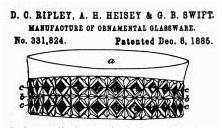National Depression Glass Association
Preserving America's Glass Manufacturing Heritage
Ruby Stained Souvenir Glass
by Orva Hiessenbuttel
Rainbow Review Glass Journal - November 1975
Judging from their advertising and articles, many dealers, collectors and scholars appear to be confused about the meaning and the use of the terms "flashed" and "stained" when used to describe certain glassware. More often than not, I note that the word "flashed" is used to describe the items of glassware which, in fact, have not been made using the flashing technique, but rather the word is used to describe glassware which have had a colored stain applied at some time after the glass was manufactured.
A brief explanation of the difference between flashed and stained is that flashed (sometimes also referred to as cased) glass consists of two layers of glass - one is clear and one is in color - whereas stained glass is glass which is merely decorated with a colored stain, applied to part of the glass when it is cold, then reheated to fix the color. Obviously, the flashing process must be done at the time of manufacture, whereas the staining process can be done at any time and usually is not used to color the entire item, only part of it.
The flashing technique of glass manufacture is most often used to produce glass of the cranberry color. Gold is one of the coloring ingredients used to produce this expensive but beautiful color; a small amount of cranberry glass is taken on the punty rod, and then it is dipped a second time in clear glass, encasing the cranberry, but giving the effect of being all one color. The opposite process is also used, usually on lead crystal; clear glass is encased in cobalt, ruby, amber, green, etc., and then a design is cut through the colored layer to the clear glass, producing a ware described as "cobalt cut to clear" (or whatever color is used). Much of the older, prized Bohemian glass was made in this manner, but most of this type of glass today is stained.
 Although the
origin of the use of stain to color glass is unknown, its use on glass
tableware dates from the last quarter of the 19th century in this
country. Collectors may refer to Dr. Arthur G. Peterson's book Glass
Patents and Patterns (1973), page 59, where reference is made to a
patent granted in 1885 to three Pittsburgh glass men - Augustus Heisey,
Daniel Ripley and George Swift. This patent was for "parti-color"
glass, with the raised surface of pressed glass having the stain
applied to it, leaving the grooves clear.
Although the
origin of the use of stain to color glass is unknown, its use on glass
tableware dates from the last quarter of the 19th century in this
country. Collectors may refer to Dr. Arthur G. Peterson's book Glass
Patents and Patterns (1973), page 59, where reference is made to a
patent granted in 1885 to three Pittsburgh glass men - Augustus Heisey,
Daniel Ripley and George Swift. This patent was for "parti-color"
glass, with the raised surface of pressed glass having the stain
applied to it, leaving the grooves clear.
Some patterns become especially popular when decorated in this manner, for example, Heisey's "Punty Band," Jefferson's "Diamond with Peg," and the ever popular "Button Arches" pattern. Although ruby was the color most often used for staining, yellow was also used, and a few other colors to a lesser degree. Some patterns were described differently when the color was applied. For example, "Kings Crown" pattern is called "Ruby Thumbprint" when the ruby decoration is used.
The use of ruby stain for decorating glassware became particularly popular at the time of the Colombian Exposition in Chicago in 1893. So many souvenirs were sold of this glass, with appropriate inscriptions such as "Aunt Jane - Chicago 1893," that it soon became known as ruby souvenir glass. The early pieces had the inscriptions engraved, then later they were done with acid-etching. Still later, only a silver-white paint was used. The fakes being produced today are done in this manner.
Although some of the glass houses decorated their own glass in this manner, in later years, most ruby-stained glassware was done by decorating firms who bought the glass (sometimes of inferior quality or closeouts of patterns) in wholesale lots from the glass factories.
Two more references to ruby-stained glass can be found in The Heisey Collector - Book 2 (1974) by this author, and the only book on the subject, Popular American Ruby-Stained Pattern Glass (1968) by Richard Carter Barrett. With 14 full color pages, Barrett's book illustrates many pieces, mostly from the 1890-1910 period.